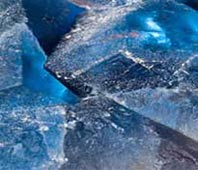
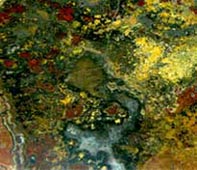
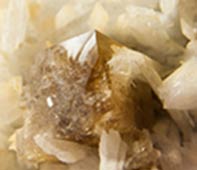
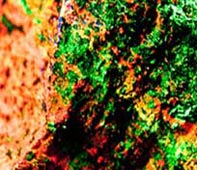
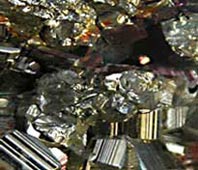
The Nature of Earth: Origin of the Universe
by Antonio Peso
From: The Pick and Dop Stick, 6/2013
10th Place — 2014 AFMS Original Adult Advanced Articles
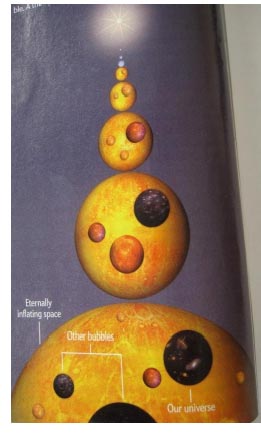
I've often thought that the place to start to understand geology is in the beginning. And in the beginning the astronomers tell us, there was no need for geology because there were no rocks. There were no minerals. There was no Earth. There were no stars. They tell us there was nothing. The science of geology has had to go beyond the confines of our own planet to gain insight into how Earth came to be and where we fit into the big picture of the universe.
One of the theories about the formation of the universe is the Big Bang Theory that says how energy was converted into matter in the form of quarks, and how hydrogen atoms were converted into helium atoms to create stars, and eventually how they eventually formed galaxies. Stars play a critical role in the formation of all matter as we know it including Earth and every living thing on it.
According to astronomers, in the beginning the universe did not exist. In the 1920's in response to Hubble's discovery that the universe was expanding, Georges Lemaitre proposed that the universe must have been originally compressed into a golf ball-sized sphere, which he called the primeval atom. Because of the conditions of temperature and pressure that would have existed in such a sphere, matter as we know it could not exist. What existed within the sphere were basic atomic particles called quarks and leptons.
Another theory proposes that the entire universe was contained within a dimensionless point called a singularity, which contained only energy. Current estimates indicate that about 13.8 billion years ago, the universe was created by an event commonly referred to as the Big Bang. In the case of primeval atom theory, the quarks and leptons were released into space in all directions. Instantly, quarks bonded to make the fundamental components of atoms, protons, neutrons, and electrons. In the case of the singularity theory, energy was converted into matter and according to Einsteinian equation, Energy equals mass times the speed of light squared, in the form of quarks.
Following the Big Bang theory, protons, electrons, and neutrons combined to create hydrogen atoms. As the hydrogen bubbles grew and moved out into space, bundles of hydrogen gas atoms, attracted by the force of gravity, began to rotate and collapse along their rotational axes. As the rotated mass collapsed, some of the gravitational energy was converted to heat. Then when temperatures within the core of the collapsing mass rose about 15 million degrees a thermonuclear reaction was initiated that converted hydrogen atoms into helium atoms. So, after a long time, the stars within the expanding mass of hydrogen gas became so numerous that they began to be attracted into big groups called galaxies. Our galaxy is the Milky Way, and Earth is located on the outer edge of this galaxy.
Stars play a critical role in the formation of all matter as we know it, including our thermonuclear reaction in which four hydrogen atoms bond together to make one helium atom. The residual mass is converted to energy and released. Stars are fires but like any fire, eventually the fuel will be exhausted and the fire will go out. Stars spend 95% of their lives as main stars, consuming hydrogen and converting it to helium. As hydrogen is converted to more massive helium atoms and a star becomes helium rich, the core of the star undergoes gravitational force, collapses, and heats up.
When the stars are large, as the core collapses, the shell will expand to as much as 100 times its original diameter to become a RED GIANT. At this stage, helium starts to be converted into bigger atoms, and carbon and oxygen, among other elements are generated. All life as we know it is based on carbon products. Every atom in our body was created in the red giant phase of a star's death. The same is true of the oxygen we breathe; plants release oxygen, but they do not create it.
A star massive enough to create an iron rich core may collapse catastrophically within a few seconds and explode to form a supernova. During a supernova, all the remaining 92 natural elements are created. The core of the original massive star may further collapse to become a neutron star. If the core is quite massive, the star may collapse into a structure with a force of gravity so great that nothing - not even light - can escape from it, and it is called a Black Hole. The remains of the star are dispersed into interstellar space to form cosmic dust that consists of particles of metal, minerals, rocks, and frozen gasses referred to collectively as ices. Basically, dark matter is cosmic dust. It will be from this mixture that future planets, forms of life and rock and minerals will be created.
Suggested Reading:
1. Hawking, S.A., A Brief History of Time: The Universe in a Nutshell. Bantam Dell. A Division of Random House, 2007.
2. Scientific American, "Quantum Gaps in Big Bang Theory", April, 2011.
3. Silk, J. A Brief History of the Universe.
For permission to reprint this article, contact us at info@chicagorocks.org.
